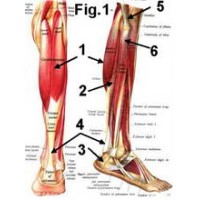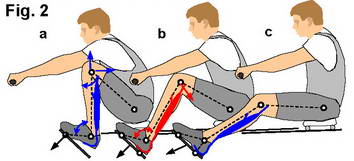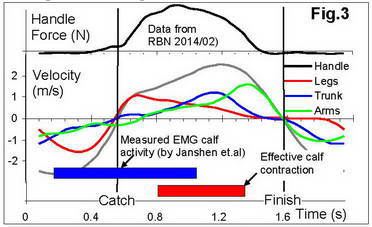Calf muscles in rowing

It is common knowledge that rowing utilises nearly all human muscles, but the function of calf muscles still remains unclear: some rowers believe these muscles are useless, but others believe they could be used at the end of the drive to extend the range of the seat movement. The first opinion could be supported by the generally very weak appearance of calf muscles in most top scullers and rowers. An argument in favour of the second point is the analogy with speed-skating, where the modern flip-skates with detachable heels allow the use of calf muscles and therefore allow increased leg power and skating speed.
The commonly called “muscle” is the trics surae (Fig.1), which is three-headed muscle and consists of a two-headed superficial gastrocnemius (1) and the deep soleus (2). At the bottom, both parts are connected to a large foot bone calcaneus (3) through the Achilles tendon (4). At the top, the gastrocnemius is attached with its two heads to the base of the femur (5) directly above the knee, and the soleus is connected to the tibia (6). Therefore, the calf is a partly bi-joint muscle and its contraction should induce ankle extension and knee flexion. As the lever at the knee joint is much shorter than at the ankle, the second action is negligible, especially at the extended knee. However, at acute knee angles, the contraction of the calf muscle could bend the knee.

How can the anatomy of the calf muscles work in rowing? At the catch, the force is transmitted through the toes, and the heels are detached from the foot-board, so the calcaneus must be stabilized, which can only be done with the tension of the Achilles tendon. However, active contraction of the calf muscle at this time would extend the ankle joint, which lifts up the knee and works against the hips extension (Fig2, a). Moreover, it could flex the knee with the action of the gastrocnemius upper heads, as described above. All these actions are counter-productive, so at the catch, the calf muscle should not contract, but only passively transmit the force produced by the muscles of the upper leg using its elastic properties.
As the rower progresses through the drive, the heels are placed on the foot-board, which gives the second point of force transmission for the foot. This is called the “transition point”, where the rower should start “opening” the trunk, switching emphasis from knee extension (using quadriceps) to hips extension (using hamstrings and glutes) (RBN 2008/07). With the centre of force located under the axis of the ankle joint, the calf muscle could remain passive (Fig.2,b). However, it was hypothesized that its contraction would induce a torque around the ankle joint, which would push the knee down and help to extend it. This action could add some power to the legs drive and be productive for faster rowing.
At the very end of the drive, some rowers try to extend the ankle by detaching their heels from the foot-board to add some extra length to their drive. Usually, this can hardly be done, because the ankle’s flexibility does not allow further extension at the common stretcher angles. Additionally, it is mechanically useless, because the trunk mass should already start its counter movement to the stern and emphasis must be placed on fast arms.

The hypothesis of the effective usage of calf muscles at the middle of the drive should be proved experimentally with simultaneous recordings of both EMG and force/power data. The most relevant study done by Janshen et al. (1) did NOT support this hypothesis: EMG recorded from gastrocnemius lateralis showed activity of this muscle only before the catch (the reason is not clear) and after it (Fig.3). Also, it was not clear if this was specific to the rowing technique of tested athletes, or if this is a general principle, and the calf muscles should be used at catch only and then remain passive?
Concluding: Possibly, the calf muscles’ contraction may be used during the middle of the drive (after the transition point) for quicker ankle and knee extension, which may produce higher power and rowing speed. To do this, pushing through the toes should continue after heels placement. During all other phases of the stroke cycle, the calf muscle should be passive.
References
Janshen L., Mattes, K., Tidow G. 2009, Muscular Coordination of the Lower Extremities of Oarsmen During Ergometer Rowing. Journal of Applied Biomechanics, 25, 156-164.



